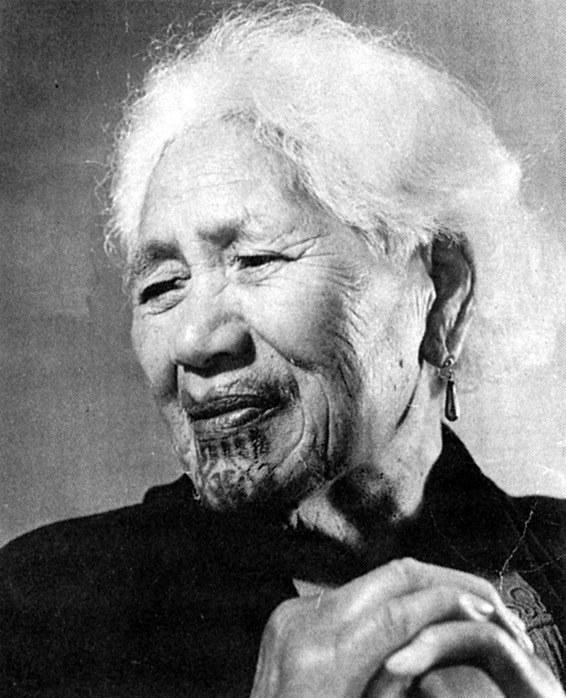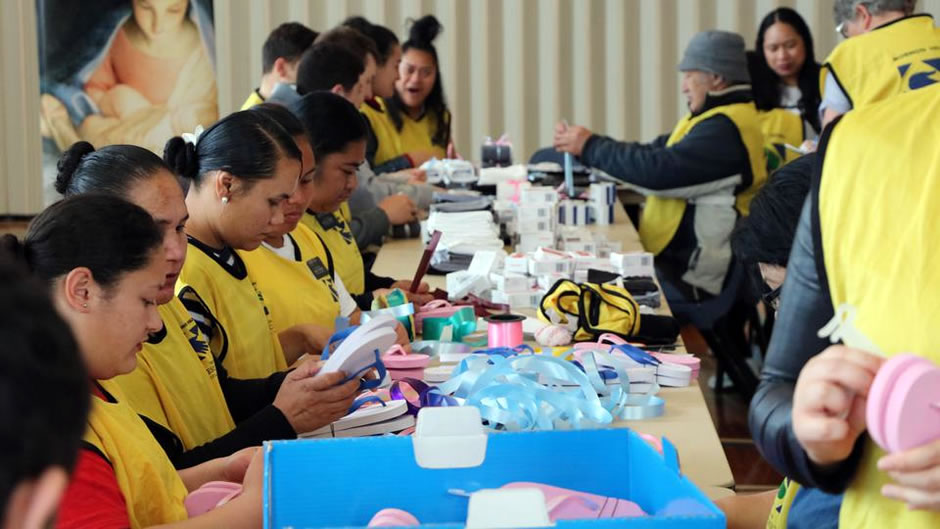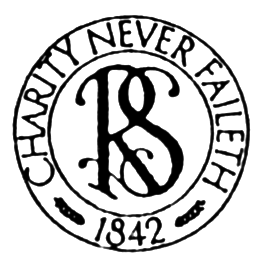This essay written by Heather Webber was first published in Women Together: a History of Women's Organisations in New Zealand in 1993. It was updated by Elizabeth Cox in 2018.
1901 – 1993
The Relief Society was formed as a voluntary women's organisation within The Church of Jesus Christ of Latter-day Saints (CJCLDS). Dedicated to works of charity, including support, friendship and education for women, it adopted the motto of 'Charity Never Faileth'. Membership was free, and open to all women members of the CJCLDS aged eighteen and over. Members were known to each other as 'sisters', emphasising the bond of sisterhood and responsibility for each other's well-being.
The inaugural Relief Society meeting was held in Illinois, USA, in 1842, when the women of the Church recognised the need for a 'Ladies' Society'. A constitution and bylaws were drafted, and presented to the Prophet Joseph Smith for his approval; in March 1842 Emma H. Smith was elected the first president. From that time, wherever branches of the CJCLDS formed, a Relief Society was also established, under the direction of a president, two counsellors and a secretary.
In April 1855 the first New Zealand branch of the CJCLDS was established in Karori, Wellington, followed by a branch in Kaiapoi in 1867. Although no formal Relief Society was then established, women who joined the church became part of the world-wide Relief Society body. New Zealand's first official Relief Society was formed in Christchurch in December 1879 by President William M. Bromley of the Australasian Mission. Sister Ann James became president, and Sisters Johanna Larsen and Agnes Doak were appointed first and second counsellors. There were thirteen other women present.

Mrs Paku Te Hau / Heather Webber.
Nannie Heke Pōmare (Turima), born in 1880, of Ngāti Kahungungu and Rongomai Wahine descent, had a 60-year association with the Relief Society, from her baptism at Māhia in 1911 until her death in Wellington in 1970.
The second society was formed in Auckland in December 1880. There are no further records of the society in New Zealand until 1897, when the Australasian Mission was divided and New Zealand became a separate mission. Church membership in New Zealand by then numbered nearly 4000, and was 90 per cent Māori. Most of the early Pākehā members of the Church had already emigrated to Utah, mainly because of the public harassment and violence they had experienced here.
The fact that Māori joined in such large numbers is partly due to three Māori tohunga, Toiroa Pakahia, King Tāwhiao of Waikato, and Paora Pōtangaroa of Te Oreore near Masterton. Each of these men had, in 1845, 1879 and 1881 respectively, prophesied concerning the coming to New Zealand of the 'true church', describing the characteristics of the CJCLDS. When missionary work began among the Māori in 1881, it took only two years to form the first Māori branch at Papawai, Wairarapa.
It is unclear how many of these early Church members were Māori women, but by 1901 the first Relief Society among Māori was organised at Te Horo, Bay of Islands, with Sister Mangu Reweti as president, and Sisters Ere Hari and Kewa Waa as counsellors. Further groups followed: one at Kirikiri, three at Te Haukē in Hawke's Bay, and two more at Māhia and Wairoa. The next year, at a hui held at Te Haukē in August 1902, 300 women voted unanimously that the Māori name for the Relief Society would be Te Hui Ātawhai A Ngā Wāhine.
It was the policy of the Church to preserve the language and culture of the Māori, and the Relief Society upheld this. Māori sisters were encouraged to continue such traditional activities as weaving flax, using natural plant dyes. It is reported that one 1908 CJCLDS bazaar was 'a revelation to the Pākehā visitors from Hastings because it represented the work of Māori women. There were many pieces ... of real Māori art, mats, kits, hats, and belts.' [1] Money raised by such means was put to good community use. The Nuhaka meeting house, the largest in the New Zealand mission, was built and paid for within nine months. The Māori sisters worked hard on this project, raising money and cooking and providing food.
Hui Tau (CJCLDS annual conferences) were well attended; at Papawai in March 1911, over 4000 were present. Most of the catering for these hui was undertaken by Māori sisters. However, for the women it was not all cooking. One day was set aside for teacher training. The women decided what should be taught, and how. Each woman was valued for her unique contribution to the education system within the Church, and the lessons offered all the sisters the opportunity both to be taught and to teach. There were also opportunities to exercise musical talent, and Māori women's participation in church choirs continued into the 1990s.
Relief Society changed over the years to accommodate changing needs. Initially the emphasis was on home duties. This followed the thinking of the day, whereby a woman's role and education was in the home, to provide a moral and clean environment for the raising of children and the comfort of husbands. However, the emphasis soon changed to incorporate giving compassionate service to the extended family and the wider community — unconditional aroha to every sister in need.
In addition, sisters were encouraged to learn skills, through the weekly education sessions, which would benefit them in their daily lives. In the early 1990s traditional home management skills were taught along with more contemporary issues, such as 'Social Forces Challenging the Latter-day Saint Woman', and 'Fighting Drug Abuse'. [2] Barbara Smith, the Relief Society's General World Wide President 1974–84, stated in 1992, 'The work of compassion in Relief Society has been both consistent and adaptable over the years. As new needs arise among our people, the work of the Relief Society is modified to meet those needs.' [3]
The Relief Society in New Zealand was built on a foundation of faith laid largely by Māori members between the 1880s and the 1950s. A resurgence of joining the CJCLDS took place among the general population in the 1950s, so that by 1992 the society had a multicultural composition and an increasing membership. That year, New Zealand membership of the Relief Society was 17,380.
Heather Webber
1994–2018
Relief Society in New Zealand continued to grow strongly after 1993. On 3 December 2018 there were 51,928 women enrolled in the Society in 224 units of the CJCLDS throughout New Zealand. The stated purpose of Relief Society was to ‘prepare women for the blessings of eternal life as they increase faith in Heavenly Father and Jesus Christ and His Atonement; strengthen individuals, families, and homes through ordinances and covenants; and work in unity to help those in need.’ In October 2018, the Prophet and President of the Church, Russell M. Nelson, encouraged Church women to ‘participate fully in Relief Society. I urge you to study the current Relief Society purpose statement. It is inspiring. It may guide you in developing your own purpose statement for your own life.’ [4]
In their homes, Relief Society women were encouraged to focus their families on a home-centred, Church-supported gospel study curriculum. They also focused on ministering to others as needed outside their immediate family circle. Relief Society charitable activities varied from unit to unit. For example, one small group of women meeting in Takapuna, Auckland, had a project sewing reusable sanitary supplies for young women on a remote Pacific Island. Another project was collating emergency kits for women in a women’s refuge. Other women from this Church unit were voluntarily engaged in teaching English as a second language. In 2015, members of the Relief Society in Tamaki, Auckland, came together over a three-month period to make 130 quilts for the Red Cross and the Salvation Army to give to those in need in the community. Faleiva Tofa, directing this project, said at the time: ‘when you’re feeling down, your problems can seem insurmountable. Volunteering to help others whose circumstances seem worse than yours can help you see your life from a different perspective.” These were a few examples of the work being done nationwide, representing thousands of hours of service. [5]

© 2018 by Intellectual Reserve, Inc. All Rights Reserved.
Relief Society members packing hygiene items for children in developing nations in December 2018 at The Church of Jesus Christ of Latter-day Saints’ Scotia Place meetinghouse in downtown Auckland.
While women could not fulfil priesthood leadership roles in the CJCLDS, they were the leaders in the Relief Society, Young Women and Primary (for children to age 12) auxiliary organisations. In a 2014 interview, a Young Women’s programme president, Naomi Waka, talked of her work, delivering a congregational youth programme which included the supervision of teachers and assistants, providing youth activity nights, pastoral care and assistance for young women. She declared, ‘As women, we have such a role to impact future families and generations ... Women can walk with their heads held high. They are great leaders.’ [6]
The variety of service activities throughout New Zealand was as diverse as the women administering them. Relief Society member, Melanie Riwai-Couch, described the ‘lovely alignment’ she saw ‘between the Church’s emphasis on family and genealogy and the Maori tradition and importance of family and whakapapa’. [7] Relief Society in 2018 was a meeting place for a diverse age-range of women; in an ever changing world, the challenges faced by the Relief Society kept shifting, but it stood poised to meet them.
Elizabeth Cox
Notes
[1] Duncan [n.d.], p. 22.
[2] Relief Society Study Guide, 1991, p. iv.
[3] Ensign, March 1992, p. 9.
[4] Purpose of the Relief Society [2018], https://www.lds.org/callings/relief-society/purposes?lang=eng; https://www.lds.org/liahona/2018/11/general-womens-session/sisters-participation-in-the-gathering-of-israel?lang=eng&clang=ase
[5] ‘Introduction to Relief Society’, https://www.lds.org/callings/relief-society/getting-started/introduction-to-relief-society?lang=eng; Tamaki Latter-day Saint Women 'Quilt for Charity', 25 June 1015, CJCLDS Newsroom: Pacific, https://www.mormonnewsroom.org.nz/article/tamaki-latter-day-saint-women-quilt-for-charity
[6] ‘New Zealand Mormon Women Discuss Leadership and Making a Difference’, 18 Dec 2014, CJCLDS Newsroom: Pacific, https://www.mormonnewsroom.org.nz/article/new-zealand-mormon-women-discuss-leadership-and-making-a-difference
[7] Newton, Marjorie, Mormon and Maori, Salt Lake City: Greg Kofford Books, 2014, pp. 171–172; Jenny Spencer, ‘The Church in New Zealand’, LDS Living website, n.d., accessed 28 Nov 2018, http://www.ldsliving.com/The-Church-in-New-Zealand/s/72873. Māori made up 46% of members of the Mormon Church in 2013. Hirini Kaa, 'Ngā hāhi – Māori and Christian denominations - Mormon Church', Te Ara - the Encyclopedia of New Zealand, http://www.TeAra.govt.nz/en/nga-hahi-maori-and-christian-denominations/page-5 (accessed 14 December 2018)
Unpublished sources
Duncan, Pare, 'New Zealand Relief Society History' [n.d.], manuscript in possession of Takana Richard Marsh, Dannevirke [in 1993]
Widdicombe, Tony, Membership and Statistical Records Supervisor, CJCLDS, personal communication, 28 July 1992
Published sources
Hunt, Brian, Zion in New Zealand [a history of the CJCLDS 1854–1977], CCNZ, Hamilton, 1977
Lineham, Peter J., 'The Mormons and Karori', Stockade, Magazine of the Karori Historical Society (inc.), No. 24, 1991, pp. 4–13
Katene, Selwyn (ed.), Turning the Hearts of the Children: Early Maori Leaders in the Mormon Church, Steele Roberts Aotearoa,Wellington, 2014
Katene, Selwyn (ed.), By their fruits you will know them: early Māori Leaders in the Mormon Church, Volume 2, Steele Roberts Aotearoa,Wellington, 2014
Newton, Marjorie, Mormon and Maori, Greg Kofford Books,Salt Lake City, 2014


Community contributions